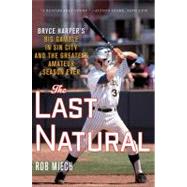
ROB MIECH has won several awards in his twenty-five-year career as a sportswriter, predominantly at the Pasadena Star-News and Las Vegas Sun. His work has appeared in many publications, including USA Today, The Washington Post, CBS SportsLine, and MLB.com.
“Like Bryce Harper, Rob Miech has all the tools, and they are on display in THE LAST NATURAL, a compelling, behind-the-scenes account of the making of a phenom.”—George Dohrmann, Pulitzer Prize-winning Senior Writer, Sports Illustrated
"In THE LAST NATURAL, Rob Miech gets the last unfettered access to baseball's next great star, Bryce Harper, before he turns pro, before he can vote, before the handlers and hangers-on and hero-worship descend. The result is a fascinating eyewitness account, a baseball version of the Beatles in Hamburg circa 1961, just before the klieg lights get switched on."—Steve Rushin, Sports Illustrated
"The Last Natural is a remarkable story of Bryce Harper’s action-packed junior-college adventure, told from the vantage point of a tremendous reporter and writer who was fortunate enough to go along on Harper’s unforgettable ride from Morse Stadium to the top of the baseball draft."—Jayson Stark, ESPN.com senior baseball writer
"Rob Miech rides the bench and the buses to craft a stirring story of a young man, an extraordinary dream and an amazing baseball season. Through an insider’s access and a reporter’s eye, Miech lays back the scouting reports to capture the real Bryce Harper—the son, the brother, the teammate and the phenom. Touching and edgy, The Last Natural captures the essence of a hard game made easy by a rare player."—Tim Brown, MLB writer, Yahoo! Sports
"The Last Natural is a fascinating tale of risk, struggle, ambition and triumph. The LeBron James of baseball is brought to life, and all his talents and warts are expertly exposed by an exceptional storyteller. Miech has done what Harper is known for—hitting a spectacular home run. Terrific stuff."—Ed Graney, Las Vegas Review-Journal sports columnist
The New copy of this book will include any supplemental materials advertised. Please check the title of the book to determine if it should include any access cards, study guides, lab manuals, CDs, etc.
The Used, Rental and eBook copies of this book are not guaranteed to include any supplemental materials. Typically, only the book itself is included. This is true even if the title states it includes any access cards, study guides, lab manuals, CDs, etc.